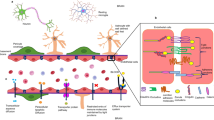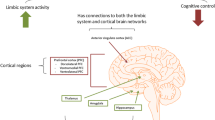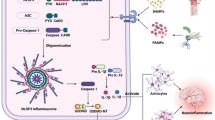Abstract
Chronic stress is an important risk factor for mood disorders including depression. The decreased level of CREB (cAMP-responsive element binding)-regulated transcription coactivator 1 (CRTC1) expression in hippocampus may be involved in depression-like behavior in some stress-induced depression models. But the mechanism of CRTC1 in mediating depression-like behavior remains unknown. In this study, chronic unpredictable mild stress (CUMS)-treated mice showed depression-like behavior accompanied by the downregulation of CRTC1 in the hippocampus. Adeno-associated virus (AAV)-CRTC1-mediated overexpression of CRTC1 in the hippocampus by stereotactic brain injection could significantly prevent depression-like behavior in CUMS-treated mice. The above data reveal that the downregulation of hippocampal CRTC1 expression participates in CUMS-induced depression-like behavior. In order to explore the key targets regulated by CRTC1, AAV-mediated CRTC1 short hairpin (shRNA) was constructed to achieve knockdown of CRTC1 in the hippocampus, and then the hippocampi were collected for RNA-sequencing (RNA-seq). The RNA-seq data show that upregulated genes were enriched in stress and immune system-associated GO terms and pathways such as response to stress and external stimulus and regulation of immune response and that downregulated genes were enriched in neural activity such as synaptic transmission and cognitive behavior. We further provided RT-qPCR data that the inflammation-related factors including Gpr84, Tlr2, Lyz2, and Icam1 were significantly upregulated in the hippocampus of both CUMS- and CRTC1 shRNA-induced models, some of them were also validated in protein levels by Western blotting. We propose a hypothesis that CUMS induces downregulation of CRTC1, which might lead to depression-like behavior via neuroinflammation pathway. This study provides new explanation for the inflammatory hypothesis of depression and some clues for exploring the molecular mechanism of CRTC1 regulation.








Similar content being viewed by others
Data Availability
The RNA-seq raw data after Crtc1 knockdown are included as supplementary files in this publication.
References
Beurel E, Toups M, Nemeroff CB (2020) The Bidirectional Relationship of Depression and Inflammation: Double Trouble. Neuron 107(2):234–256. https://doi.org/10.1016/j.neuron.2020.06.002
Hammen C (2005) Stress and depression. Annu Rev Clin Psychol 1:293–319. https://doi.org/10.1146/annurev.clinpsy.1.102803.143938
Zhou Y, Wu H, Li S, Chen Q, Cheng XW, Zheng J, Takemori H, Xiong ZQ (2007) Requirement of TORC1 for Late-phase long-term potentiation in the hippocampus. In: Biennial Meeting and the Congress of the Chinese Society for Neuroscience 1 (1):e16. https://doi.org/10.1371/journal.pone.0000016
Xu W, Kasper LH, Lerach S, Jeevan T, Brindle PK (2007) Individual CREB-target genes dictate usage of distinct cAMP-responsive coactivation mechanisms. EMBO J 26(12):2890–2903. https://doi.org/10.1038/sj.emboj.7601734
Saura CA, Cardinaux JR (2017) Emerging Roles of CREB-Regulated Transcription Coactivators in Brain Physiology and Pathology. Trends Neurosci 40(12):720–733. https://doi.org/10.1016/j.tins.2017.10.002
Uchida S, Shumyatsky GP (2018) Epigenetic regulation of Fgf1 transcription by CRTC1 and memory enhancement. Brain Res Bull 141:3–12. https://doi.org/10.1016/j.brainresbull.2018.02.016
Jagannath A, Butler R, Godinho SH, Couch Y, Brown L, Vasudevan S, Flanagan K, Anthony D et al (2013) The CRTC1-SIK1 Pathway Regulates Entrainment of the Circadian Clock. Cell 154(5):1100–1111. https://doi.org/10.1016/j.cell.2013.08.004
Breuillaud L, Rossetti C, Meylan EM, Merinat C, Halfon O, Magistretti PJ, Cardinaux JR (2012) Deletion of CREB-regulated transcription coactivator 1 induces pathological aggression, depression-related behaviors, and neuroplasticity genes dysregulation in mice. Biol Psychiatry 72(7):528–536. https://doi.org/10.1016/j.biopsych.2012.04.011
Meylan EM, Breuillaud L, Seredenina T, Magistretti PJ, Halfon O, Luthi-Carter R, Cardinaux JR (2016) Involvement of the agmatinergic system in the depressive-like phenotype of the Crtc1 knockout mouse model of depression. Transl Psychiatry 6(7):e852. https://doi.org/10.1038/tp.2016.116
Meylan EM, Halfon O, Magistretti PJ, Cardinaux JR (2016) The HDAC inhibitor SAHA improves depressive-like behavior of CRTC1-deficient mice: Possible relevance for treatment-resistant depression. Neuropharmacology 107:111–121. https://doi.org/10.1016/j.neuropharm.2016.03.012
Ni S, Huang H, He D, Chen H, Wang C, Zhao X, Chen X, Cui W et al (2019) Adeno-associated virus-mediated over-expression of CREB-regulated transcription coactivator 1 in the hippocampal dentate gyrus ameliorates lipopolysaccharide-induced depression-like behaviour in mice. J Neurochem 149(1):111–125. https://doi.org/10.1111/jnc.14670
Jiang B, Wang H, Wang JL, Wang YJ, Zhu Q, Wang CN, Song L, Gao TT et al (2019) Hippocampal Salt-Inducible Kinase 2 Plays a Role in Depression via the CREB-Regulated Transcription Coactivator 1-cAMP Response Element Binding-Brain-Derived Neurotrophic Factor Pathway. Biol Psychiatry 85(8):650–666. https://doi.org/10.1016/j.biopsych.2018.10.004
Si Y, Xue X, Liu S, Feng C, Zhang H, Zhang S, Ren Y, Ma H et al (2021) CRTC1 signaling involvement in depression-like behavior of prenatally stressed offspring rat. Behav Brain Res 399:113000. https://doi.org/10.1016/j.bbr.2020.113000
Kim D, Pertea G, Trapnell C, Pimentel H, Kelley R, Salzberg SL (2013) TopHat2: accurate alignment of transcriptomes in the presence of insertions, deletions and gene fusions. Genome Biol 14(4):R36. https://doi.org/10.1186/gb-2013-14-4-r36
Tyner C, Barber GP, Casper J, Clawson H, Diekhans M, Eisenhart C, Fischer CM, Gibson D et al (2017) The UCSC Genome Browser database: 2017 update. Nucleic Acids Res 45(D1):D626–D634. https://doi.org/10.1093/nar/gkw1134
Pruitt KD, Brown GR, Hiatt SM, Thibaudnissen F, Astashyn A, Ermolaeva O, Farrell CM, Hart J, et al. (2014) RefSeq: an update on mammalian reference sequences. Nucleic Acids Research 42 (Database issue):756–763. https://doi.org/10.1093/nar/gkt1114
Liao Y, Smyth GK, Shi W (2014) FeatureCounts: an efficient general purpose program for assigning sequence reads to genomic features. Bioinformatics 30(7):923–930. https://doi.org/10.1093/bioinformatics/btt656
Robinson MD, McCarthy DJ, Smyth GK (2010) EdgeR: a Bioconductor package for differential expression analysis of digital gene expression data. Bioinformatics 26(1):139–140. https://doi.org/10.1093/bioinformatics/btp616
Szklarczyk D, Morris JH, Cook H, Kuhn M, Wyder S, Simonovic M, Santos A, Doncheva NT et al (2017) The STRING database in 2017: quality-controlled protein–protein association networks, made broadly accessible. Nucleic Acids Res 45(D1):D362–D368. https://doi.org/10.1093/nar/gkw937
Okamura Y, Aoki Y, Obayashi T, Tadaka S, Ito S, Narise T, Kinoshita K (2015) COXPRESdb in 2015: coexpression database for animal species by DNA-microarray and RNAseq-based expression data with multiple quality assessment systems. Nucleic Acids Research 43 (Database issue):D82. https://doi.org/10.1093/nar/gku1163
Alten B, Zhou Q, Shin OH, Esquivies L, Lin PY, White KI, Sun R, Chung WK, et al. (2021) Role of Aberrant Spontaneous Neurotransmission in SNAP25-Associated Encephalopathies. Neuron 109 (1):59–72 e55. https://doi.org/10.1016/j.neuron.2020.10.012
Klockner C, Sticht H, Zacher P, Popp B, Babcock HE, Bakker DP, Barwick K, Bonfert MV et al (2021) De novo variants in SNAP25 cause an early-onset developmental and epileptic encephalopathy. Genet Med 23(4):653–660. https://doi.org/10.1038/s41436-020-01020-w
Ren Z, Yu J, Wu Z, Si W, Li X, Liu Y, Zhou J, Deng R et al (2018) MicroRNA-210-5p Contributes to Cognitive Impairment in Early Vascular Dementia Rat Model Through Targeting Snap25. Front Mol Neurosci 11:388. https://doi.org/10.3389/fnmol.2018.00388
Karmakar S, Sharma LG, Roy A, Patel A, Pandey LM (2019) Neuronal SNARE complex: A protein folding system with intricate protein-protein interactions, and its common neuropathological hallmark, SNAP25. Neurochem Int 122:196–207. https://doi.org/10.1016/j.neuint.2018.12.001
Huang TY, Zhao Y, Jiang LL, Li X, Liu Y, Sun Y, Pina-Crespo JC, Zhu B et al (2017) SORLA attenuates EphA4 signaling and amyloid beta-induced neurodegeneration. J Exp Med 214(12):3669–3685. https://doi.org/10.1084/jem.20171413
Zhang JC, Yao W, Qu Y, Nakamura M, Dong C, Yang C, Ren Q, Ma M et al (2017) Increased EphA4-ephexin1 signaling in the medial prefrontal cortex plays a role in depression-like phenotype. Sci Rep 7(1):7133. https://doi.org/10.1038/s41598-017-07325-2
Barry G, Briggs JA, Hwang DW, Nayler SP, Fortuna PR, Jonkhout N, Dachet F, Maag JL et al (2017) The long non-coding RNA NEAT1 is responsive to neuronal activity and is associated with hyperexcitability states. Sci Rep 7:40127. https://doi.org/10.1038/srep40127
Yan W, Chen ZY, Chen JQ, Chen HM (2018) LncRNA NEAT1 promotes autophagy in MPTP-induced Parkinson’s disease through stabilizing PINK1 protein. Biochem Biophys Res Commun 496(4):1019–1024. https://doi.org/10.1016/j.bbrc.2017.12.149
Johnson R (2012) Long non-coding RNAs in Huntington’s disease neurodegeneration. Neurobiol Dis 46(2):245–254. https://doi.org/10.1016/j.nbd.2011.12.006
Bai YH, Lv Y, Wang WQ, Sun GL, Zhang HH (2018) LncRNA NEAT1 promotes inflammatory response and induces corneal neovascularization. J Mol Endocrinol 61(4):231–239. https://doi.org/10.1530/JME-18-0098
Lellahi SM, Rosenlund IA, Hedberg A, Kiaer LT, Mikkola I, Knutsen E, Perander M (2018) The long non-coding RNA NEAT1 and nuclear paraspeckles are upregulated by the transcription factor HSF1 in the heat shock response. J Biol Chem 293(49):18965–18976. https://doi.org/10.1074/jbc.RA118.004473
Yan H, Rao J, Yuan J, Gao L, Huang W, Zhao L, Ren J (2017) Long non-coding RNA MEG3 functions as a competing endogenous RNA to regulate ischemic neuronal death by targeting miR-21/PDCD4 signaling pathway. Cell Death Dis 8(12):3211. https://doi.org/10.1038/s41419-017-0047-y
Liu X, Hou L, Huang W, Gao Y, Lv X, Tang J (2016) The Mechanism of Long Non-coding RNA MEG3 for Neurons Apoptosis Caused by Hypoxia: Mediated by miR-181b-12/15-LOX Signaling Pathway. Front Cell Neurosci 10:201. https://doi.org/10.3389/fncel.2016.00201
Yen YP, Hsieh WF, Tsai YY, Lu YL, Liau ES, Hsu HC, Chen YC, Liu TC et al (2018) Dlk1-Dio3 locus-derived LncRNAs perpetuate postmitotic motor neuron cell fate and subtype identity. Elife 7:e38080. https://doi.org/10.7554/eLife.38080
Zhao H, Wang X, Feng X, Li X, Pan L, Liu J, Wang F, Yuan Z et al (2018) Long non-coding RNA MEG3 regulates proliferation, apoptosis, and autophagy and is associated with prognosis in glioma. J Neurooncol 140(2):281–288. https://doi.org/10.1007/s11060-018-2874-9
Liao Q, Liu C, Yuan X, Kang S, Miao R, Xiao H, Zhao G, Luo H et al (2011) Large-scale prediction of long non-coding RNA functions in a coding-non-coding gene co-expression network. Nucleic Acids Res 39(9):3864–3878. https://doi.org/10.1093/nar/gkq1348
Wang YJ, Liu L, Wang Y, Wang JL, Gao TT, Wang H, Chen TT, Guan W et al (2020) Imipramine exerts antidepressant-like effects in chronic stress models of depression by promoting CRTC1 expression in the mPFC. Brain Res Bull 164:257–268. https://doi.org/10.1016/j.brainresbull.2020.08.028
Li M, Li C, Yu H, Cai X, Shen X, Sun X, Wang J, Zhang Y et al (2017) Lentivirus-mediated interleukin-1beta (IL-1beta) knock-down in the hippocampus alleviates lipopolysaccharide (LPS)-induced memory deficits and anxiety- and depression-like behaviors in mice. J Neuroinflammation 14(1):190. https://doi.org/10.1186/s12974-017-0964-9
Pan Y, He X, Li C, Li Y, Li W, Zhang H, Wang Y, Zhou G et al (2021) Neuronal activity recruits the CRTC1/CREB axis to drive transcription-dependent autophagy for maintaining late-phase LTD. Cell Rep 36(3):109398. https://doi.org/10.1016/j.celrep.2021.109398
Madeddu S, Woods TA, Mukherjee P, Sturdevant D, Butchi NB, Peterson KE (2015) Identification of Glial Activation Markers by Comparison of Transcriptome Changes between Astrocytes and Microglia following Innate Immune Stimulation. PLoS ONE 10(7):e0127336. https://doi.org/10.1371/journal.pone.0127336
Recio C, Lucy D, Purvis GSD, Iveson P, Zeboudj L, Iqbal AJ, Lin D, O’Callaghan C et al (2018) Activation of the Immune-Metabolic Receptor GPR84 Enhances Inflammation and Phagocytosis in Macrophages. Front Immunol 9:1419. https://doi.org/10.3389/fimmu.2018.01419
Xu Y, Sheng H, Bao Q, Wang Y, Lu J, Ni X (2016) NLRP3 inflammasome activation mediates estrogen deficiency-induced depression- and anxiety-like behavior and hippocampal inflammation in mice. Brain Behav Immun 56:175–186. https://doi.org/10.1016/j.bbi.2016.02.022
Medina-Rodriguez EM, Cheng Y, Michalek SM, Beurel E, Jope RS (2020) Toll-like receptor 2 (TLR2)-deficiency impairs male mouse recovery from a depression-like state. Brain Behav Immun 89:51–58. https://doi.org/10.1016/j.bbi.2020.05.068
Bui TM, Wiesolek HL, Sumagin R (2020) ICAM-1: A master regulator of cellular responses in inflammation, injury resolution, and tumorigenesis. J Leukoc Biol 108(3):787–799. https://doi.org/10.1002/JLB.2MR0220-549R
Muller N (2019) The Role of Intercellular Adhesion Molecule-1 in the Pathogenesis of Psychiatric Disorders. Front Pharmacol 10:1251. https://doi.org/10.3389/fphar.2019.01251
Latorre J, Lluch A, Ortega FJ, Gavalda-Navarro A, Comas F, Moron-Ros S, Rodriguez A, Becerril S et al (2021) Adipose tissue knockdown of lysozyme reduces local inflammation and improves adipogenesis in high-fat diet-fed mice. Pharmacol Res 166:105486. https://doi.org/10.1016/j.phrs.2021.105486
Moreno-Navarrete JM, Latorre J, Lluch A, Ortega FJ, Comas F, Arnoriaga-Rodriguez M, Ricart W, Fernandez-Real JM (2021) Lysozyme is a component of the innate immune system linked to obesity associated-chronic low-grade inflammation and altered glucose tolerance. Clin Nutr 40(3):1420–1429. https://doi.org/10.1016/j.clnu.2020.08.036
Acknowledgements
We thank for the technical support by the Core Facilities, Ningbo University School of Medicine.
Funding
This research was supported by the National Natural Science Foundation of China [grant numbers 81171036, 81371224], by the Natural Science Foundation of Zhejiang Province [grant number LY19H090003] and by the Natural Science Foundation of Ningbo [grant number 2018A610288]. This project was also sponsored by K.C. Wong Magna Fund in Ningbo University.
Author information
Authors and Affiliations
Contributions
FZ designed and supervised the study. DZL performed the stereotaxic delivery, behavioral tests, and RT-qPCR with the help of CW and XWC. YT performed RNA-seq analysis with the help of QL and DSZ. SQN performed virus verification and WB with the help of XXL. DLX and XCJ contributed to the data analysis. JFZ, DZL, and QL wrote the manuscript, JFZ secured funding for the project. All authors discussed the results and approved the final manuscript.
Corresponding author
Ethics declarations
Ethics Approval
All animal experiments were carried out in accordance with the National Institute of Health Guide for the Care and Use of Laboratory Animals (8th edition, National Research Council) and approved by the Institutional Animal Care and Use Committee of the Medical School of Ningbo University (SYXK(ZHE)2013–0191).
Consent to Participate
Not applicable.
Consent for Publication
Not applicable.
Conflict of Interest
The authors declare no competing interests.
Additional information
Publisher's Note
Springer Nature remains neutral with regard to jurisdictional claims in published maps and institutional affiliations.
Rights and permissions
About this article
Cite this article
Li, D., Liao, Q., Tao, Y. et al. Downregulation of CRTC1 Is Involved in CUMS-Induced Depression-Like Behavior in the Hippocampus and Its RNA Sequencing Analysis. Mol Neurobiol 59, 4405–4418 (2022). https://doi.org/10.1007/s12035-022-02787-6
Received:
Accepted:
Published:
Issue Date:
DOI: https://doi.org/10.1007/s12035-022-02787-6









